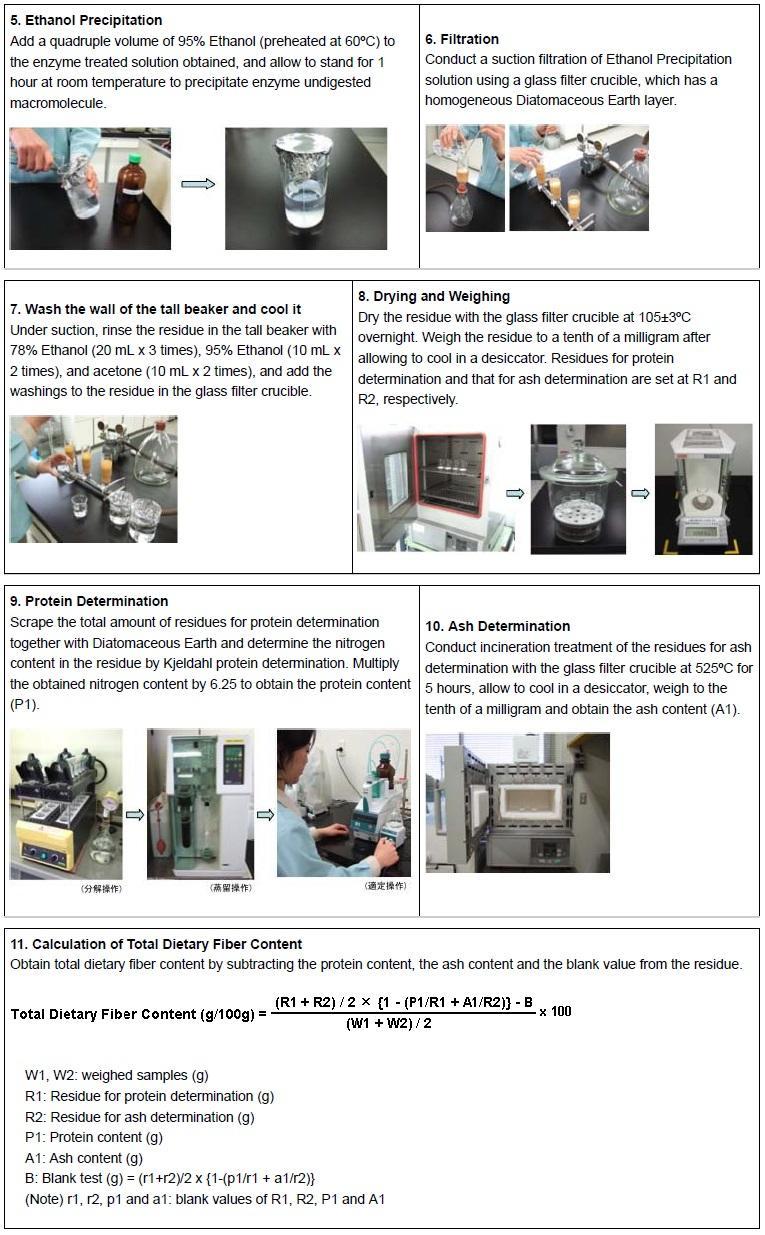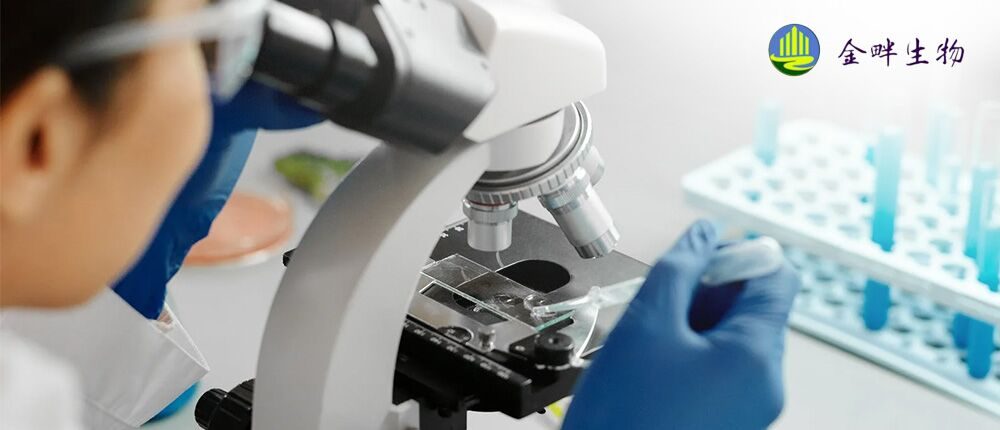Wako 291-59701 膳食纤维试剂盒,Dietary Fiber Assay Kit
英文名称:Dietary Fiber Assay Kit
中文名称:膳食纤维试剂盒
品牌:wako;
货号:291-59701
包装:100 tests
类别:糖苷
我司所销售的化学试剂、原料等所有产品(包括但不限于抗生素类、蛋白质类、试剂盒类产品等)仅限用于科学研究用途,不得作用于人体。
本产品是Prosky法里简化酶处理的改进法(日本食物纤维学会法 001.2007)里使用的酶组合。可使食物纤维检测变得更简单。
· 特点
· 操作方法
· 实验例子
· 产品讯息
· 参考文献
特点
·操作简单
·检测精确度高
·酶处理时间是旧方法的1/2
· 检测步骤概要请查看本公司刊物《食品检测·分析试剂》
实验例子
【实例1】定量日本销售的小麦粉中的食物纤维
| Prosky法 | 原始方法 | |
| 检测次数 | 10次 | 10次 |
| 平均值 (g/100g) | 1.82 | 2.19 |
| 变动系数(%) | 36.6 | 11.4 |
【实例2】 定量日本销售的大麦中的食物纤维
| Prosky法 | 原始方法 | |
| 检测次数 | 10次 | 10次 |
| 平均值 (g/100g) | 5.31 | 5.60 |
| 变动系数(%) | 12.1 | 3.66 |
产品讯息
| 产品编号 | 品 名 | 规 格 | 包 装 |
| 291-59701 | 食物纤维检测试剂盒 (Dietary Fiber Assay Kit) |
食品分析用 | 100次 |
参考文献
1. Tada. S., Innami. S.:/J.AOAC International/ 90. 217. (2007)
2. Kanaya. K., Tada. S./ et.at/: /J.AOAC International/ 90. 225. (2007)
【本试剂盒以外的必要试剂】
| 产品编号 | 品 名 | 规 格/生产商 | 包 装 |
| 酶处理必要试剂 | |||
| 341-01622 | 2-(N-Morpholino)ethanesulfonic Acid (MES) | 同仁 | 25g |
| 203-06272 | 2-Amino-2-hydroxymethyl-1,3-propanediol(TRIS) | 试剂特级 | 25g |
| 191-01665 | Sodium Chloride (NaCl) | 试剂特级 | 500g |
| 039-00431 | Calcium Chloride Dihydrate(Cacl2) | 试剂特级 | 100g |
| 051-00476 | Ethanol (95) | 试剂特级 | 500ml |
| 016-00346 | Acetone | JIS特级 | 500ml |
| 169-04485 | Potassium Sulfate (K2SO4) | 试剂特级 | 500g |
| 039-04412 | Copper (Ⅱ) Sulfate Pentahydrate (CuSO4・5H2O) |
试剂特级 | 25g |
| 192-04696 | Sulfuric Acid | 试剂特级 | 500ml |
| 081-04215 | Hydrogen Peroxide (30) (H2O2) | 试剂特级 | 500ml |
| 027-02192 | Boric Acid (H3BO3) | 试剂特级 | 25g |
| 020-14571 | Bromocresol Green-Methyl Red Ethanol Solution | 滴定用 | 100ml |
| 199-08621 | Sodium Hydroxide (NaOH) | 氮气检测用 | 100g |
本试剂只作试验、研究目的,不作医药品、食品、家庭用品等用途。
本产品仅供研究用。不要把它给人类使用。
Kit Contents
- Thermostable alpha-Amylase Solution (20 mL x 1 vial)
- Protease Solution (20 mL x 1 vial)
- Amyloglucosidase Solution (20 mL x 1 vial)
- Diatomaceous Earth (100 g x 1 vial)
Procedures


Example Data
【sample1】 amount of dietary fiber in commercial flour
| Prosky method | our kit | |
|---|---|---|
| number of measurements | 10 times | 10 times |
| average (g/100g) | 1.82 | 2.19 |
| coefficient of variation (%) | 36.6 | 11.4 |
【sample 2】amount of dietary fiber in commercial barley
| Prosky method | our kit | |
|---|---|---|
| number of measurements | 10 times | 10 times |
| average (g/100g) | 5.31 | 5.60 |
| coefficient of variation (%) | 12.1 | 3.66 |
References
- Tada. S., Innami. S.:J.AOAC International. 90. 217. (2007)
- Kanaya. K., Tada. S. et.al: J.AOAC International. 90. 225. (2007)
普洛斯基方法的一个简单的修正版本。与传统的Prosky方法相比,该方法具有较高的测量精度。此外,缩短了酶处理时间。
试剂盒组成:
-
- 耐热α-淀粉酶溶液1小瓶x 20 mL
-
- 蛋白酶溶液1小瓶x20 mL
-
- 酰胺葡萄糖苷酶溶液1小瓶x20 mL
- 硅藻土1小瓶x100克
测量轮廓
-
- 在MES/TRIS缓冲液中溶解的样品
-
- 耐热α-淀粉酶消化
-
- 蛋白酶和淀粉糖苷酶的消化
-
- 在pH6.3和60℃下持续30分钟
-
- 乙醇沉淀
-
- 休假1小时
-
- 过滤
-
- 乙醇和丙酮洗涤
-
- 一夜干
-
- Kjeldahl蛋白测定及灰分测定
- 总膳食纤维测定
原理
-
- 膳食纤维总量的测定
-
- 样品中的可消化组分,如淀粉和蛋白质,会被水解。
-
- 用α-淀粉酶、蛋白酶和淀粉糖苷酶,通过添加四倍体积的95%乙醇沉淀未分解的残余大分子,然后用含硅藻土的玻璃过滤坩埚捕获。
-
- 总膳食纤维含量是通过从玻璃过滤坩埚上捕获的残渣的干重中扣除蛋白质和灰分的含量来确定的。
-
- 可溶性膳食纤维和不溶性膳食纤维含量的分数分析
-
- 样品中的可消化组分,如淀粉和蛋白质,用α-淀粉酶、蛋白酶和淀粉糖苷酶水解,然后用含硅藻土的玻璃过滤坩埚过滤。
-
- 不溶性膳食纤维含量是通过在玻璃过滤坩埚上从不溶性残渣的干重中扣除蛋白质和灰分的含量来确定的。
-
- 同时,在滤液中加入四倍体积的95%乙醇,沉淀未分解的可溶性大分子,用含硅藻土的玻璃过滤坩埚捕集。可溶性膳食纤维含量是通过从玻璃过滤坩埚上沉淀残渣的干重中扣除蛋白质和灰分的含量来确定的。
-
- 总膳食纤维含量定义为不溶性膳食纤维含量和可溶性膳食纤维含量之和。
-
- 低分子可溶性膳食纤维的测定
-
-
- 用高效液相色谱法测定了特定的低分子可溶性膳食纤维,即使加入四倍体积的95%乙醇也不会沉淀。
-
- 用α-淀粉酶、蛋白酶和淀粉葡萄糖苷酶水解样品中的淀粉和蛋白质等可消化组分,再加入四倍体积的95%乙醇沉淀未分解的残余大分子。然后用含硅藻土的玻璃过滤坩埚过滤。
-
- 利用离子交换树脂去除滤液中的蛋白质、有机酸和无机盐,并将其应用于高效液相色谱。低分子可溶性膳食纤维含量是由样品的峰面积与葡萄糖的峰面积(内标)在色谱图上的比值来确定的。
-
- 同时,通过在玻璃过滤坩埚上从沉淀残渣的干重中扣除蛋白质和灰分的含量,确定了不溶性和可溶性大分子膳食纤维的含量。
-
总膳食纤维含量定义为低分子可溶性膳食纤维含量和不溶性和可溶性大分子膳食纤维含量之和。
This product is for research use only. Do not administer it to human.
A simple and modified version of Prosky’s method. Compared to conventional Prosky’s method, it assures high measurement accuracy. Furthermore, enzyme treatment time is shortened.
Kit Contents
-
- Thermostable alpha-Amylase Solution 1 vial x 20 mL
-
- Protease Solution 1 vial x 20 mL
-
- Amyloglucosidase Solution 1 vial x 20 mL
- Diatomaceous Earth 1 vial x 100 g
Measurement Outline
-
- Sample dissolved in MES/Tris buffer
-
- Digestion with thermostable alpha-amylase
-
- Digestion with protease and amyloglucosidase
-
- for 30 minutes at pH 6.3 and 60 degrees C
-
- Ethanol Precipitation
-
- Leave 1 hour
-
- Filtration
-
- Wash with ethanol and acetone
-
- Dry overnight
-
- Kjeldahl Protein Determination and Ash Determination
- Total Dietary Fiber Determination
Principle
-
-
- Determination of total Dietary Fiber Contents
-
- Digestible components in samples, such as starch and protein, are hydrolyzed
-
- with alpha-amylase, protease, and amyloglucosidase, precipitate undecomposed residual macromolecule by adding quadruple volume 95% Ethanol, and then trapped with a glass filter crucible containing diatomaceous earth.
-
- Total Dietary Fiber Contents are determined by deducting weight of protein and ash content from the dry weight of trapped residue on a glass filter crucible.
-
- Fractional Analysis of Soluble Dietary Fiber Contents and Insoluble Dietary Fiber Contents
-
- Digestible components in samples, such as starch and protein, are hydrolyzed with alpha-amylase, protease, and amyloglucosidase, then filtrated with a glass filter crucible containing diatomaceous earth.
-
- Insoluble Dietary Fiber Contents are determined by deducting weight of protein and ash content from the dry weight of trapped insoluble residue on a glass filter crucible.
-
- Meanwhile, add a quadruple volume 95% Ethanol into the filtrate, precipitate undecomposed residual soluble macromolecule, and trap with a glass filter crucible containing diatomaceous earth. Soluble Dietary Fiber Contents are determined by deducting weight of protein and ash content from the dry weight of the trapped precipitated residue on a glass filter crucible.
-
- Total Dietary Fiber Contents are defined as the sum of Insoluble Dietary Fiber Contents and Soluble Dietary Fiber Contents.
-
- Determination of Low-molecular Soluble Dietary Fiber
-
- Specific Low-molecular Soluble Dietary Fibers, which are not precipitated even by addition of a quadruple volume of 95% Ethanol, are determined by high-performance liquid chromatography.
-
- After digestible components such as starch and protein in samples are hydrolyzed with alpha-amylase, protease, and amyloglucosidase, the undecomposed residual macromolecule are precipitated by adding a quadruple volume of 95% Ethanol. Then filter it with a glass filter crucible containing diatomaceous earth.
-
- Proteins, organic acids and inorganic salts in the filtrate are removed with ion-exchange resin, and then the solution is applied to high-performance liquid chromatography. Low-molecular Soluble Dietary Fiber Content is determined by the ratio of the peak area of the sample with that of glucose (internal standard) on the chromatogram.
-
- Meanwhile, Insoluble and Soluble Macromolecule Dietary Fiber Content is determined by deducting weight of protein and ash content from the dry weight of the trapped precipitated residue on a glass filter crucible.
-
Total Dietary Fiber Contents is defined as sum of Low-molecular Soluble Dietary Fiber Contents and Insoluble and Soluble Macromolecular Dietary Fiber Contents.
